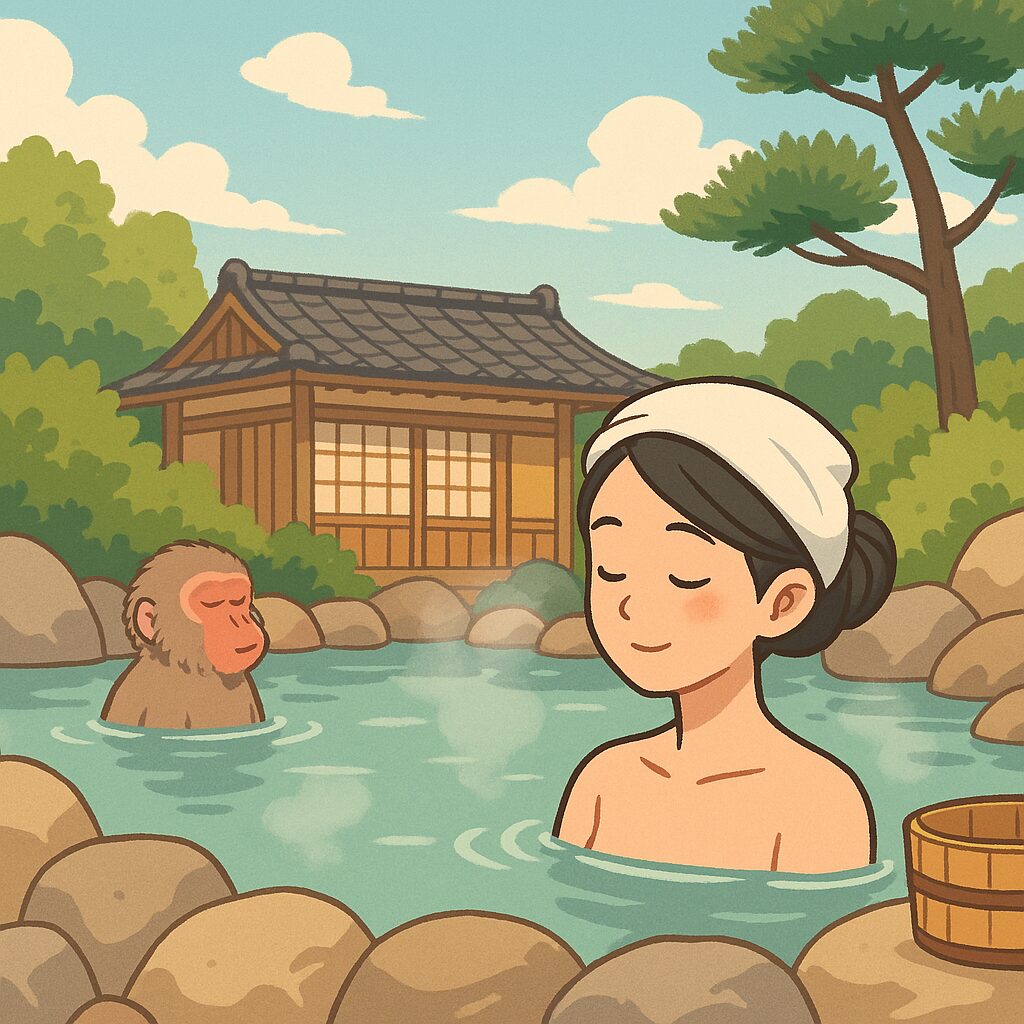July 26th marks “Summer Bath Day” in Japan, a celebration born from a clever play on numbers (7-2-6 = “natsu-furo”). But beyond the pun lies a profound cultural truth: the Japanese love for bathing transcends seasons, centuries, and even species.
- 🌋 Nature’s Gift: Japan, the Land of Hot Springs
- 🐒 Even Monkeys Bathe: The Snow Monkeys of Jigokudani
- 🏞️ Ancient Bathing Traditions: From Stone Saunas to Ritual Cleansing
- ⛩️ Bathing in Mythology: The Story of Izanagi
- 🏯 Edo-Era Bathhouses: Social Hubs of the Common People
- 🧼 Modern Evolution: From Communal Baths to Personal Sanctuaries
- 🌍 Why Foreign Visitors Should Experience Japanese Hot Springs
- 🧭 Onsen Etiquette for First-Time Visitors
- ✨ Conclusion: Bathing as a Cultural Mirror
🌋 Nature’s Gift: Japan, the Land of Hot Springs
Japan is one of the world’s most volcanically active countries, with over 3,000 hot spring areas scattered across its islands. From ancient times, people have embraced these geothermal blessings not just for hygiene, but for healing, relaxation, and spiritual cleansing.
- Hot springs were seen as divine gifts
- Early bathing practices were deeply tied to nature
- Regional variations in mineral content led to unique bathing traditions
🐒 Even Monkeys Bathe: The Snow Monkeys of Jigokudani
Bathing in Japan isn’t just for humans. In Jigokudani Monkey Park, wild Japanese macaques famously soak in hot springs during the snowy months.
Why do monkeys bathe?
| Reason | Explanation |
| Cold protection | Temperatures drop below −10°C in winter |
| Social bonding | Females and young monkeys bathe together |
| Fur advantage | Their oily fur repels water and retains heat |
This behavior isn’t taught—it’s instinctive. It’s a testament to how deeply bathing is embedded in Japan’s natural rhythm.
🏞️ Ancient Bathing Traditions: From Stone Saunas to Ritual Cleansing
Long before Buddhism arrived, Japan had its own bathing customs:
- Stone steam baths (ishiburo) were used in the Jōmon and Yayoi periods
- Heated rocks and seaweed created sauna-like environments
- These practices were found in places like Nara and Sado Island
Bathing was not just physical—it was spiritual purification, often linked to Shinto rituals like misogi, where water cleansed the soul.
⛩️ Bathing in Mythology: The Story of Izanagi
In Japan’s oldest myths, the god Izanagi bathed in a river to cleanse himself after visiting the underworld. This act of purification became a template for spiritual renewal, influencing both Shinto and Buddhist bathing practices.
🏯 Edo-Era Bathhouses: Social Hubs of the Common People
By the Edo period, bathing had become a daily ritual for the masses:
- Sento (public bathhouses) flourished in cities
- Bathing was a communal activity, fostering social bonds
- Innovations like “zakuro-guchi” doors preserved steam and warmth
Bathhouses were more than places to wash—they were centers of community life.
🧼 Modern Evolution: From Communal Baths to Personal Sanctuaries
With modernization came new forms of bathing:
- Meiji-era reforms emphasized hygiene and privacy
- Showa-era homes introduced private bathtubs
- Today, bathing is a personal ritual of relaxation and mindfulness
Modern trends include:
- Yudō (Bathing Way): a philosophy akin to tea ceremony
- Aromatherapy, carbonated baths, and mood lighting
- Bathing as a form of self-care and emotional reset
🌍 Why Foreign Visitors Should Experience Japanese Hot Springs
For international travelers, Japanese onsen offer a rare cultural immersion:
- Nature + tradition: soak in mountain views or snowy landscapes
- Local cuisine: enjoy hot spring eggs, regional dishes, and sake
- Healing properties: each spring has unique mineral benefits
Top Onsen Destinations for Foreign Visitors
| Rank | Onsen Area | Highlights |
| 1 | Kusatsu (Gunma) | Powerful acidic waters, traditional “yumomi” |
| 2 | Beppu (Oita) | Largest output, “hell tours” and steam cuisine |
| 3 | Hakone (Kanagawa) | Views of Mt. Fuji, easy access from Tokyo |
| 4 | Arima (Hyogo) | Historic “gold” and “silver” springs |
| 5 | Dogo (Ehime) | Japan’s oldest onsen, literary heritage |
🧭 Onsen Etiquette for First-Time Visitors
| Tip | Description |
| Wash before entering | Clean your body thoroughly |
| No towels in the bath | Leave them outside or on your head |
| No photos | Respect privacy and tradition |
| Gender separation | Most baths are divided by gender |
✨ Conclusion: Bathing as a Cultural Mirror
From ancient stone saunas to snow monkeys, from spiritual cleansing to modern wellness, Japanese bathing culture reflects a deep harmony with nature, community, and self.
Whether you’re a local rediscovering tradition or a traveler seeking authenticity, a dip in a Japanese onsen is a journey into the heart of Japan.



コメント